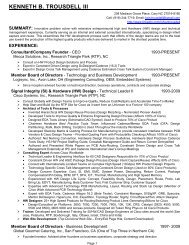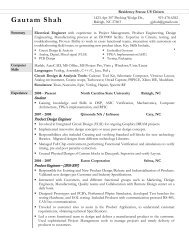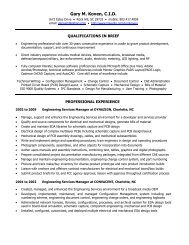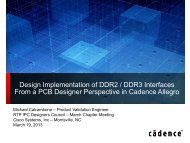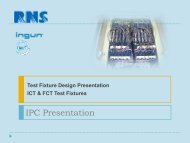HyperLynx – High Speed PCB Design Workshop - RTP Designers ...
HyperLynx – High Speed PCB Design Workshop - RTP Designers ...
HyperLynx – High Speed PCB Design Workshop - RTP Designers ...
Create successful ePaper yourself
Turn your PDF publications into a flip-book with our unique Google optimized e-Paper software.
Mentor Graphics<br />
DDR DDR Memory So So Easy, AA Caveman<br />
Can Can Do Do It It<br />
© Mentor Graphics Corp., 2005, Reuse by written<br />
permission only. All rights reserved.<br />
Steve McKinney<br />
Technical Marketing Engr.<br />
Steven_McKinney@mentor.com
Agenda<br />
DDR Memory design<br />
1. DDR/DDR2 Technology Overview<br />
2. DDR/DDR2 Challenges and Layout Guidelines<br />
3. Introduction to DDR3<br />
4. Wrap up<br />
Strobe<br />
<strong>HyperLynx</strong> <strong>–</strong> <strong>High</strong> <strong>Speed</strong> <strong>PCB</strong> <strong>Design</strong> <strong>Workshop</strong><br />
2<br />
Data
*Courtesy of Hynix Semiconductor<br />
Memory Trends<br />
<strong>HyperLynx</strong> <strong>–</strong> <strong>High</strong> <strong>Speed</strong> <strong>PCB</strong> <strong>Design</strong> <strong>Workshop</strong><br />
3
DDR Overview<br />
� Double Data Rate (DDR) Memory<br />
— Data is “clocked” in on both the rising and<br />
falling edge of the synchronous strobe signal<br />
� Source-synchronous interface<br />
— Clock (Strobe) is routed along<br />
the same path as the data<br />
— Data/Strobe signals are bi-directional<br />
— Each data group has a corresponding<br />
strobe to minimize skew (data groups are<br />
4, 8, or 16 bits wide) and optimize timing<br />
DQS<br />
DQ0<br />
DQ1<br />
DQ2<br />
Strobe<br />
<strong>HyperLynx</strong> <strong>–</strong> <strong>High</strong> <strong>Speed</strong> <strong>PCB</strong> <strong>Design</strong> <strong>Workshop</strong><br />
4<br />
DQS<br />
DQ0<br />
DQ1<br />
DQ2<br />
Data
� DDR Operating <strong>Speed</strong>s<br />
— DDR200 (100 MHz clock)<br />
— DDR266 (133 MHz clock)<br />
— DDR333 (166.67 MHz clock)<br />
— DDR400 (200 MHz clock)<br />
DDR Technology<br />
Memory<br />
Controller<br />
Strobe<br />
Series<br />
Resistor<br />
<strong>HyperLynx</strong> <strong>–</strong> <strong>High</strong> <strong>Speed</strong> <strong>PCB</strong> <strong>Design</strong> <strong>Workshop</strong><br />
DIMM Slot 1<br />
DIMM Slot 2<br />
Data<br />
Data<br />
5<br />
VTT Pull-up<br />
Resistors
DDR Bandwidth<br />
� Improved bandwidth over Single Data Rate (SDR) memory<br />
— Same clock speed gives 2X the bandwidth<br />
PC100<br />
800 MB/s<br />
Memory Bandwidth (Single Channel)<br />
SDR - SDRAM<br />
PC133<br />
1.1 GB/s<br />
DDR200<br />
1.6 GB/s<br />
DDR - SDRAM<br />
DDR266<br />
2.1 GB/s<br />
DDR333<br />
2.7 GB/s<br />
<strong>HyperLynx</strong> <strong>–</strong> <strong>High</strong> <strong>Speed</strong> <strong>PCB</strong> <strong>Design</strong> <strong>Workshop</strong><br />
DDR400<br />
3.2 GB/s<br />
6
� Termination<br />
— Requires series<br />
termination<br />
� Series terminator<br />
on DIMMs<br />
� Series terminator<br />
on your <strong>PCB</strong><br />
— Pull-up termation to Vtt<br />
DDR Termination<br />
Memory<br />
Controller<br />
Series<br />
Resistor<br />
SDRAM<br />
Series<br />
Resistor<br />
<strong>HyperLynx</strong> <strong>–</strong> <strong>High</strong> <strong>Speed</strong> <strong>PCB</strong> <strong>Design</strong> <strong>Workshop</strong><br />
DIMM Slot 1<br />
. . . . .<br />
SDRAM<br />
Gold Finger Connector<br />
DIMM Slot 2<br />
7<br />
VTT Pull-up Resistors
DDR DIMM Technology<br />
� DIMMS come in many configurations<br />
— x4, x8, x16 SDRAM devices<br />
— 1 or 2 Physical Memory Banks<br />
— Registered or Unbuffered Address/CMD signals<br />
— Non-parity (x64 bits) or ECC (x72 bits)<br />
� Tend to have the same routing even if from different<br />
vendors<br />
— Many manufacturers share DIMM layout data<br />
<strong>HyperLynx</strong> <strong>–</strong> <strong>High</strong> <strong>Speed</strong> <strong>PCB</strong> <strong>Design</strong> <strong>Workshop</strong><br />
8
DDR Unbuffered DIMMs<br />
� Address signals - Unbuffered<br />
— Data/Strobe<br />
— Address/Control<br />
<strong>HyperLynx</strong> <strong>–</strong> <strong>High</strong> <strong>Speed</strong> <strong>PCB</strong> <strong>Design</strong> <strong>Workshop</strong><br />
9
DDR Registered DIMMs<br />
� Address signals - Registered<br />
— Data/Strobe<br />
— Address/Control<br />
<strong>HyperLynx</strong> <strong>–</strong> <strong>High</strong> <strong>Speed</strong> <strong>PCB</strong> <strong>Design</strong> <strong>Workshop</strong><br />
10
DDR Electrical Characteristics<br />
— DDR uses SSTL_2 buffer technology<br />
� 2.5V technology<br />
� Class I drivers for point to<br />
point connection <strong>–</strong> Half drive strength<br />
� Class II drivers for multi-drop<br />
connection <strong>–</strong> Full drive strength<br />
— Some important voltages to remember<br />
� Vref = 1.25V<br />
— Used for setting up timing thresholds (Vih and Vil)<br />
— Must be kept stable<br />
� Vih = 1.56V Nominal<br />
— Vref + 0.31 - Logic high threshold<br />
� Vil = 0.97V Nominal<br />
— Vref <strong>–</strong> 0.31 - Logic low threshold<br />
Vih<br />
Vref<br />
Vil<br />
<strong>HyperLynx</strong> <strong>–</strong> <strong>High</strong> <strong>Speed</strong> <strong>PCB</strong> <strong>Design</strong> <strong>Workshop</strong><br />
11
DDR Timing Characteristics<br />
— Flight time measurements into a JEDEC test load<br />
� 30 pF to Ground<br />
� 50 ohm pull-up to Vref (nominally 1.25V)<br />
— Some important timing parameters<br />
needed for timing equations<br />
� Setup time parameters<br />
— Tck = Clock cycle time<br />
— Tipw = DQ and DM pulse width<br />
— Tdipw = Address Control pulse width<br />
— Tdqsh/l = DQS high/low pulse width<br />
— Tds = DQ and DM setup time to DQS<br />
— Tdqsq = DQS setup skew from<br />
associated DQ/DM signals<br />
— Tdss = Falling edge DQS to CLK setup time<br />
— Tis = Address/CMD setup time to CLK<br />
� Hold time parameters<br />
— Tck = Clock cycle time<br />
— Tipw = DQ and DM pulse width<br />
— Tdipw = Address Control pulse width<br />
— Tdqsh/l = DQS high/low pulse width<br />
— Tdh = DQ and DM hold time to DQS<br />
— Tdqhq = DQS hold skew between associated<br />
DQ/DM signals<br />
— Tdsh = Falling edge DQS hold time from CLK<br />
— Tih = Address/CMD hold time to CLK<br />
<strong>HyperLynx</strong> <strong>–</strong> <strong>High</strong> <strong>Speed</strong> <strong>PCB</strong> <strong>Design</strong> <strong>Workshop</strong><br />
12
DDR Impedance Characteristics<br />
— Recommended impedance of 60 ohms<br />
� Best to simulate with different impedance<br />
values to determine the best solution<br />
<strong>HyperLynx</strong> <strong>–</strong> <strong>High</strong> <strong>Speed</strong> <strong>PCB</strong> <strong>Design</strong> <strong>Workshop</strong><br />
13
� DDR2 Operating <strong>Speed</strong>s<br />
— DDR2-400 (200 MHz clock)<br />
— DDR2-533 (266 MHz clock)<br />
— DDR2-667 (333 MHz clock)<br />
— DDR2-800 (400 MHz clock)<br />
� Source-Synchronous<br />
interface like original DDR<br />
DDR2 Technology<br />
DQS<br />
DQ0<br />
DQ1<br />
DQ2<br />
Strobe Strobe<br />
<strong>HyperLynx</strong> <strong>–</strong> <strong>High</strong> <strong>Speed</strong> <strong>PCB</strong> <strong>Design</strong> <strong>Workshop</strong><br />
Data<br />
14<br />
DQS<br />
DQ0<br />
DQ1<br />
DQ2<br />
Data
DDR2 Bandwidth<br />
� Not necessarily improved bandwidth over DDR<br />
— Original DDR2 has higher latency than<br />
DDR reducing effective bandwidth.<br />
— New lower latency DDR2 memory<br />
modules are improving this gap<br />
DDR333<br />
2.7 GB/s<br />
Memory Bandwidth (Single Channel)<br />
DDR<br />
DDR400<br />
3.2 GB/s<br />
DDR2-<br />
400<br />
3.2 GB/s<br />
DDR2-<br />
533<br />
4.266 GB/s<br />
DDR2<br />
DDR2-<br />
667<br />
5.33 GB/s<br />
<strong>HyperLynx</strong> <strong>–</strong> <strong>High</strong> <strong>Speed</strong> <strong>PCB</strong> <strong>Design</strong> <strong>Workshop</strong><br />
DDR2-<br />
800<br />
6.4 GB/s<br />
15
DDR2 On Die Termination<br />
� ODT <strong>–</strong> On Die Termination<br />
— Built into the controller<br />
and SDRAM<br />
— Offers multiple termination<br />
values for different configurations<br />
� 50 Ohm, 75 Ohm, 150 Ohm<br />
— Turns on or off depending<br />
on Read/Write cycle<br />
<strong>HyperLynx</strong> <strong>–</strong> <strong>High</strong> <strong>Speed</strong> <strong>PCB</strong> <strong>Design</strong> <strong>Workshop</strong><br />
* Courtesy of Micron<br />
16
DDR2 On Die Termination<br />
� How ODT works <strong>–</strong> Example of a 2 module system<br />
— Write operation<br />
� ODT off at Controller<br />
� DIMM receiving data has<br />
ODT of 150 Ohms<br />
� DIMM not receiving data<br />
has ODT of 75 Ohms<br />
— Read operation<br />
� ODT off at driving DIMM<br />
� ODT 150 Ohms at Controller<br />
� DIMM not driving has ODT of 75 Ohms<br />
<strong>HyperLynx</strong> <strong>–</strong> <strong>High</strong> <strong>Speed</strong> <strong>PCB</strong> <strong>Design</strong> <strong>Workshop</strong><br />
* Courtesy of Micron<br />
17
DDR2 DIMM Technology<br />
� Same as DDR, DIMMs come in many configurations<br />
— x4, x8, x16 SDRAM devices<br />
— 1, 2 or 4 Rank (or Bank) DIMMs<br />
— Registered or Unbuffered Address/CMD signals<br />
— Non-ECC (x64 bits) or ECC (x72 bits)<br />
— Parity or no Parity for Address signals<br />
— Stacked or un-Stacked components<br />
� DIMM layout is controlled by JEDEC<br />
— Many manufacturers shared responsibility of creating the DIMM<br />
layout data<br />
<strong>HyperLynx</strong> <strong>–</strong> <strong>High</strong> <strong>Speed</strong> <strong>PCB</strong> <strong>Design</strong> <strong>Workshop</strong><br />
18
— Data/Strobe<br />
DDR2 Unbuffered DIMMs<br />
— ODT control<br />
24 pF<br />
— Address/Control<br />
5.1 Ohm<br />
<strong>HyperLynx</strong> <strong>–</strong> <strong>High</strong> <strong>Speed</strong> <strong>PCB</strong> <strong>Design</strong> <strong>Workshop</strong><br />
19
— Data/Strobe<br />
DDR2 Registered DIMMs<br />
— ODT Control<br />
— Address/Control<br />
<strong>HyperLynx</strong> <strong>–</strong> <strong>High</strong> <strong>Speed</strong> <strong>PCB</strong> <strong>Design</strong> <strong>Workshop</strong><br />
20
DDR2 Electrical Characteristics<br />
— DDR2 uses SSTL18 buffer technology<br />
� 1.8V technology<br />
� Class I drivers for point to<br />
point connection <strong>–</strong> Half drive strength<br />
� Class II drivers for multi-drop<br />
connection <strong>–</strong> Full drive strength<br />
— Some important voltages to remember<br />
� Vref = 900 mV<br />
— Used for setting up switching thresholds (Vih and Vil)<br />
� Vih/Vil AC Thresholds<br />
— = Vref +/- 250 mV for DDR2-400 & 533<br />
— = Vref +/- 200 mV for DDR2-667 & 800<br />
� Vih/Vil DC Thresholds<br />
— =Vref +/- 125 mV for all DDR2<br />
Vih ac<br />
Vih dc<br />
Vref<br />
Vil dc<br />
Vil ac<br />
<strong>HyperLynx</strong> <strong>–</strong> <strong>High</strong> <strong>Speed</strong> <strong>PCB</strong> <strong>Design</strong> <strong>Workshop</strong><br />
21
DDR2 Timing Characteristics<br />
— Flight time measurements into a JEDEC test load<br />
� 25 ohm pull-up to Vtt (nominally 900 mV)<br />
— Some important timing parameters<br />
needed for timing equations<br />
� Setup time parameters<br />
— Tck = Clock cycle time<br />
— Tipw = DQ and DM pulse width<br />
— Tdipw = Address Control pulse width<br />
— Tdqsh/l = DQS high/low pulse width<br />
— Tds = DQ and DM setup time to DQS<br />
— Tdqsq = DQS setup skew from<br />
associated DQ/DM signals<br />
— Tdss = Falling edge DQS to CLK setup time<br />
— Tis = Address/CMD setup time to CLK<br />
� Hold time parameters<br />
— Tck = Clock cycle time<br />
— Tipw = DQ and DM pulse width<br />
— Tdipw = Address Control pulse width<br />
— Tdqsh/l = DQS high/low pulse width<br />
— Tdh = DQ and DM hold time to DQS<br />
— Tdqhq = DQS hold skew between associated<br />
DQ/DM signals<br />
— Tdsh = Falling edge DQS hold time from CLK<br />
— Tih = Address/CMD hold time to CLK<br />
<strong>HyperLynx</strong> <strong>–</strong> <strong>High</strong> <strong>Speed</strong> <strong>PCB</strong> <strong>Design</strong> <strong>Workshop</strong><br />
22
DDR2 Timing Characteristics<br />
� Signal derating required to meet setup and hold times<br />
— Find nominal slew rate<br />
� Setup � Hold<br />
<strong>HyperLynx</strong> <strong>–</strong> <strong>High</strong> <strong>Speed</strong> <strong>PCB</strong> <strong>Design</strong> <strong>Workshop</strong><br />
23
� Setup<br />
DDR2 Timing Characteristics<br />
— If any of the signal falls to<br />
the right of the nominal slew<br />
rate in the switching region,<br />
signal must be derated<br />
� Hold<br />
— If any of the signal falls to<br />
the left of the nominal slew<br />
rate in the switching region,<br />
signal must be derated<br />
<strong>HyperLynx</strong> <strong>–</strong> <strong>High</strong> <strong>Speed</strong> <strong>PCB</strong> <strong>Design</strong> <strong>Workshop</strong><br />
24
DDR2 Timing Characteristics<br />
� Setup slew rate measurement<br />
— Rising Edge<br />
� Last crossing of Vref + DC Guard-band<br />
to first crossing of Vih-ac<br />
— Falling Edge<br />
� Last crossing of Vref <strong>–</strong> DC Guard-band<br />
to first crossing of Vil-ac<br />
� Hold slew rate measurement<br />
— Rising Edge<br />
� First crossing of Vil-dc to the<br />
first crossing of Vref <strong>–</strong> AC Guard-band<br />
— Falling Edge<br />
� First crossing of Vih-dc to the<br />
first crossing of Vref + AC Guard-band<br />
Vih ac<br />
Vih dc<br />
Vref +<br />
Guard-band<br />
Vref<br />
Vref <strong>–</strong><br />
Guard-band<br />
Vil dc<br />
Vil ac<br />
<strong>HyperLynx</strong> <strong>–</strong> <strong>High</strong> <strong>Speed</strong> <strong>PCB</strong> <strong>Design</strong> <strong>Workshop</strong><br />
25
DDR2 Timing Characteristics<br />
� Derate or Prorate setup and hold times based on slew<br />
rate information<br />
<strong>HyperLynx</strong> <strong>–</strong> <strong>High</strong> <strong>Speed</strong> <strong>PCB</strong> <strong>Design</strong> <strong>Workshop</strong><br />
26
� Why Derating?<br />
DDR2 Timing Characteristics<br />
— Consider the area under the curve <strong>–</strong> Charge Model concept<br />
Vih AC<br />
Vref<br />
+ Δt - Δt<br />
2 V/ns<br />
1 V/ns<br />
0.5 V/ns<br />
<strong>HyperLynx</strong> <strong>–</strong> <strong>High</strong> <strong>Speed</strong> <strong>PCB</strong> <strong>Design</strong> <strong>Workshop</strong><br />
27
DDR2 Impedance Characteristics<br />
— Recommended impedance of 50 ohms<br />
� 10 ohms lower than DDR<br />
� Simulate with different impedance<br />
values to determine the best solution<br />
<strong>HyperLynx</strong> <strong>–</strong> <strong>High</strong> <strong>Speed</strong> <strong>PCB</strong> <strong>Design</strong> <strong>Workshop</strong><br />
28
Agenda<br />
DDR Memory design<br />
1. DDR/DDR2 Technology Overview<br />
2. DDR/DDR2 Challenges and Layout Guidelines<br />
3. Introduction to DDR3<br />
4. Wrap up<br />
Strobe<br />
<strong>HyperLynx</strong> <strong>–</strong> <strong>High</strong> <strong>Speed</strong> <strong>PCB</strong> <strong>Design</strong> <strong>Workshop</strong><br />
29<br />
Data
DDR/DDR2 <strong>Design</strong> Challenges<br />
Reflections and Skew<br />
� Reflections seen on<br />
signal edges<br />
� Skew between DQ bits<br />
consuming timing budget<br />
<strong>HyperLynx</strong> <strong>–</strong> <strong>High</strong> <strong>Speed</strong> <strong>PCB</strong> <strong>Design</strong> <strong>Workshop</strong><br />
30
DDR/DDR2 <strong>Design</strong> Challenges<br />
Address timing<br />
� Very little timing budget for Address/Control<br />
signals under heavily loaded conditions<br />
<strong>HyperLynx</strong> <strong>–</strong> <strong>High</strong> <strong>Speed</strong> <strong>PCB</strong> <strong>Design</strong> <strong>Workshop</strong><br />
31
DDR/DDR2 <strong>Design</strong> Challenges<br />
Crosstalk<br />
� Crosstalk on Strobe Signals<br />
— Often seen as “glitches” on the strobe edges<br />
— Can cause double clocking<br />
<strong>HyperLynx</strong> <strong>–</strong> <strong>High</strong> <strong>Speed</strong> <strong>PCB</strong> <strong>Design</strong> <strong>Workshop</strong><br />
32
DDR/DDR2 <strong>Design</strong> Challenges<br />
Power Plane Stability<br />
� Vref and VDD Stability<br />
— SSO can cause fluctuations in<br />
Vref due to inadequate decoupling<br />
� Causes the Vref level to shift which changes the Vih and Vil<br />
switching thresholds<br />
Memory<br />
Controller<br />
<strong>HyperLynx</strong> <strong>–</strong> <strong>High</strong> <strong>Speed</strong> <strong>PCB</strong> <strong>Design</strong> <strong>Workshop</strong><br />
DIMM Slot 1<br />
VDD VTT<br />
DIMM Slot 2<br />
33<br />
VTT Pull-up Resistors
DDR <strong>Design</strong> Guidelines<br />
� What results are important<br />
— We need to constrain 4 critical lengths<br />
1. Net length from the controller to the 1st DIMM slot<br />
2. Net length between DIMM slots<br />
3. Net length from last<br />
slot to the Termination<br />
4. All DQS/DQ groups<br />
Memory<br />
should be length<br />
Controller<br />
matched to minimize<br />
skew within the group<br />
and across the channel<br />
VDD VTT<br />
#1 #2 #3<br />
<strong>HyperLynx</strong> <strong>–</strong> <strong>High</strong> <strong>Speed</strong> <strong>PCB</strong> <strong>Design</strong> <strong>Workshop</strong><br />
DIMM Slot 1<br />
DIMM Slot 2<br />
VTT Pull-up Resistors<br />
34
DDR <strong>Design</strong> Guidelines<br />
� What results are important<br />
— #1 This length is typically between 2” and 6” but<br />
dependant on the controller used and how many<br />
DIMMs are supported in a channel<br />
— Keep the series terminator as close as possible to<br />
the controller - typically within 1”<br />
� This length counts as part of the<br />
overall constraint for length #1<br />
Memory<br />
Controller<br />
<strong>HyperLynx</strong> <strong>–</strong> <strong>High</strong> <strong>Speed</strong> <strong>PCB</strong> <strong>Design</strong> <strong>Workshop</strong><br />
VDD<br />
#1<br />
35<br />
DIMM Slot 1
DDR <strong>Design</strong> Guidelines<br />
� What results are important<br />
— #2 This length is typically<br />
between 400 mils to 1.2”<br />
— Wider = Better airflow = Improved Thermals<br />
— But too wide can<br />
VDD<br />
produce poor signal<br />
quality (SI)<br />
<strong>HyperLynx</strong> <strong>–</strong> <strong>High</strong> <strong>Speed</strong> <strong>PCB</strong> <strong>Design</strong> <strong>Workshop</strong><br />
DIMM Slot<br />
#2<br />
DIMM Slot<br />
36
DDR <strong>Design</strong> Guidelines<br />
� What results are important<br />
— #3 This length does not have to be as tightly<br />
constrained as the other lengths since it only<br />
goes to a termination<br />
� No timing importance here<br />
— Typical constraint is from<br />
500 mils to 2”<br />
<strong>HyperLynx</strong> <strong>–</strong> <strong>High</strong> <strong>Speed</strong> <strong>PCB</strong> <strong>Design</strong> <strong>Workshop</strong><br />
DIMM Slot<br />
VDD<br />
#3<br />
37<br />
VTT<br />
VTT Pull-up Resistors
DDR <strong>Design</strong> Guidelines<br />
� What results are important<br />
— #4 This constraint is very critical.<br />
— A data group (DQ) has an associated strobe (DQS);<br />
— This group should be length matched to each other with<br />
minimum skew<br />
— Typical constraints are about 50 mils within the group<br />
� Try to spread this out across the channel<br />
� +/- 25 mils for length #1<br />
� +/- 15 mils for length #2<br />
� +/- 15 mils for length #3<br />
� Helps to minimize skew<br />
between the DIMMs<br />
Memory<br />
Controller<br />
<strong>HyperLynx</strong> <strong>–</strong> <strong>High</strong> <strong>Speed</strong> <strong>PCB</strong> <strong>Design</strong> <strong>Workshop</strong><br />
DIMM Slot 1<br />
VDD VTT<br />
#1 #2 #3<br />
DIMM Slot 2<br />
38<br />
VTT Pull-up Resistors
DDR <strong>Design</strong> Guidelines<br />
� Spacing Recommendations<br />
— Varies depending on stackup<br />
— Typically rules of thumb say 3H spacing<br />
� For a 6 mil dielectric this would be 18 mils<br />
� For signals coupled closely to reference planes, often<br />
1.5H can be used<br />
<strong>HyperLynx</strong> <strong>–</strong> <strong>High</strong> <strong>Speed</strong> <strong>PCB</strong> <strong>Design</strong> <strong>Workshop</strong><br />
39
� Terminations<br />
DDR <strong>Design</strong> Guidelines<br />
— Use discrete components for DQS lines<br />
— R-packs typically have poor isolation<br />
� Causes Crosstalk problems on strobes<br />
<strong>HyperLynx</strong> <strong>–</strong> <strong>High</strong> <strong>Speed</strong> <strong>PCB</strong> <strong>Design</strong> <strong>Workshop</strong><br />
40
DDR2 <strong>Design</strong> Guidelines<br />
� What results are important<br />
— We need to constrain 4 critical lengths<br />
1. Net length from the controller to the 1st DIMM slot<br />
2. Net length between DIMM slots<br />
3. Net length from last<br />
slot to the pull-up termination<br />
(only Address/Command)<br />
Memory<br />
4. All DQS/DQ groups<br />
Controller<br />
should be length<br />
matched to minimize<br />
skew within the group<br />
and across the channel<br />
<strong>HyperLynx</strong> <strong>–</strong> <strong>High</strong> <strong>Speed</strong> <strong>PCB</strong> <strong>Design</strong> <strong>Workshop</strong><br />
VDD VTT<br />
#1 #2 #3<br />
DIMM Slot 1<br />
DIMM Slot 2<br />
41<br />
VTT Pull-up Resistors
DDR2 <strong>Design</strong> Guidelines<br />
� What results are important<br />
— #1 This length from the<br />
controller to the first DIMM<br />
is typically between 1.9” and<br />
4.5”<br />
Memory<br />
Controller<br />
VDD<br />
#1<br />
DIMM Slot 1<br />
— #2 The length<br />
between the DIMMs<br />
is typically around<br />
425 mils<br />
<strong>HyperLynx</strong> <strong>–</strong> <strong>High</strong> <strong>Speed</strong> <strong>PCB</strong> <strong>Design</strong> <strong>Workshop</strong><br />
DIMM Slot<br />
#2<br />
VDD<br />
DIMM Slot<br />
42
DDR2 <strong>Design</strong> Guidelines<br />
� What results are important<br />
— #3 The length from the last DIMM to the pullup<br />
resistors is typically 200 mils to 550 mils<br />
� Only applies to the Address and Command nets <strong>–</strong><br />
Data nets use ODT<br />
� No timing importance here<br />
DIMM Slot<br />
VDD<br />
#3<br />
VTT<br />
<strong>HyperLynx</strong> <strong>–</strong> <strong>High</strong> <strong>Speed</strong> <strong>PCB</strong> <strong>Design</strong> <strong>Workshop</strong><br />
VTT Pull-up Resistors<br />
43
DDR2 <strong>Design</strong> Guidelines<br />
� What results are important<br />
— #4 This constraint is very critical.<br />
— A data group (DQ) has an associated strobe (DQS);<br />
— This group should be length matched to each other with<br />
minimum skew<br />
— Typical constraints are about 50 mils within the group<br />
� Try to spread this out across the channel<br />
� +/- 30 mils for length #1<br />
� +/- 20 mils for length #2<br />
� Overall skew between byte<br />
lanes should be +/- 500 mils<br />
� Skew between address nets<br />
should be +/- 200 mils<br />
Memory<br />
Controller<br />
<strong>HyperLynx</strong> <strong>–</strong> <strong>High</strong> <strong>Speed</strong> <strong>PCB</strong> <strong>Design</strong> <strong>Workshop</strong><br />
DIMM Slot 1<br />
VDD<br />
DIMM Slot 2<br />
44<br />
VTT<br />
VTT Pull-up Resistors
DDR2 <strong>Design</strong> Guidelines<br />
� Spacing Recommendations<br />
— Varies depending on stackup<br />
— Typically rules of thumb say 3H spacing<br />
� For a 5 mil dielectric this would be 15 mils<br />
� For signals coupled closely to reference planes, often<br />
1.5H can be used or ~8 mils<br />
<strong>HyperLynx</strong> <strong>–</strong> <strong>High</strong> <strong>Speed</strong> <strong>PCB</strong> <strong>Design</strong> <strong>Workshop</strong><br />
45
Agenda<br />
DDR Memory design<br />
1. DDR/DDR2 Technology Overview<br />
2. DDR/DDR2 Challenges and Layout Guidelines<br />
3. Introduction to DDR3<br />
4. Wrap up<br />
Strobe<br />
<strong>HyperLynx</strong> <strong>–</strong> <strong>High</strong> <strong>Speed</strong> <strong>PCB</strong> <strong>Design</strong> <strong>Workshop</strong><br />
46<br />
Data
Data Rate<br />
System support<br />
Signaling<br />
Technology<br />
DQS signals<br />
ODT<br />
Signal leveling<br />
DDR Feature Comparison<br />
DDR<br />
200 - 400 Mbps<br />
4 slots <strong>–</strong> 8 loads<br />
SSTL_2<br />
Bi-directional<br />
single ended<br />
No<br />
No<br />
DDR2<br />
400 <strong>–</strong> 800 Mbps<br />
2 slots <strong>–</strong> 4 loads<br />
SSTL_18<br />
Bi-directional single<br />
or differential<br />
Yes<br />
No<br />
DDR3<br />
SSTL_15<br />
Bi-directional<br />
differential<br />
Yes<br />
Yes<br />
<strong>HyperLynx</strong> <strong>–</strong> <strong>High</strong> <strong>Speed</strong> <strong>PCB</strong> <strong>Design</strong> <strong>Workshop</strong><br />
800 <strong>–</strong> 1600 Mbps<br />
2 slots <strong>–</strong> 4 loads<br />
1600 Mbps = 1 slot<br />
47
DDR Market Trends<br />
<strong>HyperLynx</strong> <strong>–</strong> <strong>High</strong> <strong>Speed</strong> <strong>PCB</strong> <strong>Design</strong> <strong>Workshop</strong><br />
48
DDR3 Market Trends<br />
� Main growth in the 512 Mb<br />
and 1Gb memory modules<br />
— Early adopters starting with 256 Mb modules<br />
<strong>HyperLynx</strong> <strong>–</strong> <strong>High</strong> <strong>Speed</strong> <strong>PCB</strong> <strong>Design</strong> <strong>Workshop</strong><br />
49
� DDR3 has a peak transfer<br />
rate of 1600 MT/s<br />
— 800 MHz clocks<br />
DDR3 Performance<br />
— Provides a 2X bandwidth<br />
increase over DDR2<br />
— Maximum bus bandwidth<br />
of 12,800 MT/s<br />
� 4 operating speeds for DDR3<br />
— 800 MT/s<br />
— 1067 MT/s<br />
— 1333 MT/s<br />
— 1600 MT/s<br />
<strong>HyperLynx</strong> <strong>–</strong> <strong>High</strong> <strong>Speed</strong> <strong>PCB</strong> <strong>Design</strong> <strong>Workshop</strong><br />
50
Lower Power<br />
� Supply voltage reduced from 1.8V to 1.5V<br />
— 30% reduction in power supply voltage<br />
� <strong>High</strong>er impedance driver requires less current<br />
— Driver impedance of 34 ohms vs. 18 ohms in DDR2<br />
<strong>HyperLynx</strong> <strong>–</strong> <strong>High</strong> <strong>Speed</strong> <strong>PCB</strong> <strong>Design</strong> <strong>Workshop</strong><br />
51
DDR3 Architecture<br />
� 800 MT/s <strong>–</strong> 1333 MT/s will support 2 DIMM slots<br />
— Margins will be tight for<br />
1333 MT/s on Read<br />
operations<br />
� 1600 MT/s only supports<br />
1 DIMM slot<br />
— Can not achieve reliable<br />
data transfer with 2 slots<br />
<strong>HyperLynx</strong> <strong>–</strong> <strong>High</strong> <strong>Speed</strong> <strong>PCB</strong> <strong>Design</strong> <strong>Workshop</strong><br />
52
Fly-by Architecture<br />
� Address, Control, and Clocks use Fly-by architecture vs.<br />
branch architecture for routing<br />
— Daisy-chain topology for these signals<br />
� Provides improved signal quality<br />
— Reduces number of stubs and their length<br />
� Requires write leveling to optimize timing<br />
— Fly-by creates too much skew between clock and strobe<br />
<strong>HyperLynx</strong> <strong>–</strong> <strong>High</strong> <strong>Speed</strong> <strong>PCB</strong> <strong>Design</strong> <strong>Workshop</strong><br />
53
Write Leveling<br />
� Write leveling adjusts the DQS to CK relationship by the<br />
controller<br />
— Uses a simple feedback provided by the DRAM<br />
� Memory controller has an adjustable delay setting on DQS<br />
— Used to align the rising edge of DQS with the clock at the DRAM pin<br />
� DRAM asynchronously feeds back CK sampled with the rising<br />
edge of DQS<br />
� The controller repeatedly delays DQS until a transition from 0 to 1<br />
is detected and determines DQS delay<br />
<strong>HyperLynx</strong> <strong>–</strong> <strong>High</strong> <strong>Speed</strong> <strong>PCB</strong> <strong>Design</strong> <strong>Workshop</strong><br />
54
Termination<br />
� On-Die Termination used for Data/Strobes<br />
— Dynamic and controllable as in DDR2<br />
� Address, Command, and Control signals no longer<br />
require pull-up terminations on <strong>PCB</strong><br />
— Termination is on DIMM module<br />
� 39 ohm pull-up termination<br />
Source: Samsung Electronics<br />
<strong>HyperLynx</strong> <strong>–</strong> <strong>High</strong> <strong>Speed</strong> <strong>PCB</strong> <strong>Design</strong> <strong>Workshop</strong><br />
55
Lead-in vs. Loaded routing<br />
� Neck down traces on DIMM modules to<br />
compensate for capacitive loads<br />
— Increases impedance on traces<br />
— 55 ohms on <strong>PCB</strong> and 60 ohms on module<br />
Zo =<br />
<strong>HyperLynx</strong> <strong>–</strong> <strong>High</strong> <strong>Speed</strong> <strong>PCB</strong> <strong>Design</strong> <strong>Workshop</strong><br />
L<br />
C<br />
56
Agenda<br />
DDR Memory design<br />
1. DDR/DDR2 Technology Overview<br />
2. DDR/DDR2 Challenges and Layout Guidelines<br />
3. Introduction to DDR3<br />
4. Wrap up<br />
Strobe<br />
<strong>HyperLynx</strong> <strong>–</strong> <strong>High</strong> <strong>Speed</strong> <strong>PCB</strong> <strong>Design</strong> <strong>Workshop</strong><br />
57<br />
Data
� DDR and DDR2 designs<br />
Summary<br />
— Data/Strobe signals tend to be easier to route for SI<br />
� Want to minimize skew in the byte lanes<br />
— Address/Control signals have most SI problems<br />
� DDR3<br />
� Due to loading conditions and branch topologies<br />
— Signal always worst at the first DIMM module<br />
— No real layout guidelines available yet since the<br />
technology is still being developed<br />
� Expect heavy adoption in 2009<br />
<strong>HyperLynx</strong> <strong>–</strong> <strong>High</strong> <strong>Speed</strong> <strong>PCB</strong> <strong>Design</strong> <strong>Workshop</strong><br />
58
Additional Technology <strong>Design</strong> kits<br />
� USB<br />
� DDR<br />
� DDR2<br />
� PCI/PCI-X<br />
� SATA<br />
� PCI Express<br />
� FibreChannel<br />
� SAS<br />
� Embedded DDR<br />
� HyperTransport<br />
� HDMI<br />
<strong>HyperLynx</strong> <strong>–</strong> <strong>High</strong> <strong>Speed</strong> <strong>PCB</strong> <strong>Design</strong> <strong>Workshop</strong><br />
59
<strong>HyperLynx</strong> <strong>Design</strong> Kits<br />
http://www.mentor.com/hyperlynx/customer/examples/<br />
<strong>HyperLynx</strong> <strong>–</strong> <strong>High</strong> <strong>Speed</strong> <strong>PCB</strong> <strong>Design</strong> <strong>Workshop</strong><br />
60
Acknowledgments<br />
� Special thanks to Micron for providing a majority<br />
of the DDR3 content and DDR2 routing guidelines<br />
— Reference their DDR3 Advantages presentation<br />
— www.micron.com<br />
� Samsung Electronics<br />
— Providing feature comparison and topology and<br />
impedance information for DDR3<br />
— www.samsung.com<br />
<strong>HyperLynx</strong> <strong>–</strong> <strong>High</strong> <strong>Speed</strong> <strong>PCB</strong> <strong>Design</strong> <strong>Workshop</strong><br />
61
<strong>HyperLynx</strong> <strong>–</strong> <strong>High</strong> <strong>Speed</strong> <strong>PCB</strong> <strong>Design</strong> <strong>Workshop</strong><br />
62





